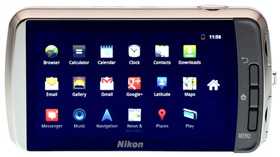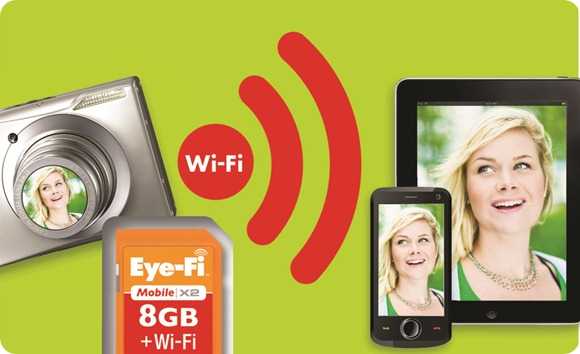At HiBlue, the focus is on the next generation of smart cameras – cameras that are fully converged with a mobile operating system and communication options that we see on smartphones. The devices haven’t hit the market yet but they’re coming. For some they’ll be an exciting and creative enhancement to photography but to others, they may not be the best solution.
The case against Smart Cameras say they are too converged and that a modular solution of dedicated camera and separate smartphone or tablet-based app/communication hub is better. Eye-Fi have been promoting this type of solution for a while now and separating the camera and ‘smart’ device’ is also the core of the Samsung Smart Camera strategy for the time being. So what’s the real deal? What are the advantages and disadvantages of the next generation of smart cameras?
They key question is one of mobility and ease of use. Do you need to be mobile? In which case you need a camera and mobile connectivity. While there are solutions for all types of smart, connected and cameraphones, the converged solution, with 3G or 4G, will always be the smallest, lightest and most mobile solution. Sure, If you’re looking at a professional camera, image management and editing tool for example then the modular solutions could be the best and the Eye-Fi or Samsung WiFi approach could bring advantages.
 The Case for a converged smart camera.
The Case for a converged smart camera.
Cameraphones have limits. Due to size restrictions that get tighter and tighter every year there are a whole bunch of issues. Zoom lenses are the biggest hurdle as they require thicknesses that aren’t acceptable in a phone. Optical stabilization is another technology that isn’t possible in a cameraphone. Large sensors (and therefore good low-light sensitivity) are also restricted by the size of cameraphones. Battery life is restricted, there’s no place for on-device controls and connectors and in many countries, it’s hard to buy cameraphones off the shelf without a multi-year phone contract.
The next generation of smart cameras will solve these issues.
In terms of on-device capability, the smart camera with mobile operating systems is going to far exceed anything on a dedicated camera. The simple ability to use any of hundreds of third party applications is a clear advantage.
A smart camera using the same OS as your phone has clear advantages. You’ll be using the same online account and will be able to access all the photos taken by your smart camera without using any 3rd-party online services. For example, Google Plus, an key part of the Google Android online services offering can be used to upload all your photo’s to an online folder where they are instantly available on your PC, phone or tablet.
Speed of sharing is going to be as fast as a phone, but with much higher quality and far more creative options. In some cases you’ll be able to push the image directly to multiple services and as apps get developed, that could include auto-resizing, multiple resizing and watermarking. Video clips could also get automated titles, fades and re-compression for incredibly fast uploads. Finally, live video coverage is likely to be easier on a converged smart camera unit.
Redundancy. When you’ve got a long chain of hardware, the chances of a failure (power, hardware, software or user error) are much higher than with a converged system. However, if you choose the right modular components in your chain, you remove single points of failure.
Converged smart cameras are likely to use one of a few mobile operating systems meaning many users will be instantly familiar with the operating systems. Communities will build around the operating systems and applications because of their wide adoption among camera users. The market for new and interesting image processing applications will become much bigger.
Fun, discovery, community. This is one element of the smart camera that could be a real driver. If communities start to build around smart camera devices running the same operating system then interesting and unpredictable things could happen. This is an area that we’re sure Apple will be looking at as an advantage for any photo-capable device they bring into the market.
Converged smart cameras will have limits though. We see smart cameras going into a consumer marketplace which means that professional needs may not be met.
 The case for a modular smart camera solution.
The case for a modular smart camera solution.
Converged solutions are going to be expensive so if you’ve already got a smartphone and a camera then perhaps an Eye-Fi solution with WiFi-Direct to your smartphone, is the easiest and cheapest first-step into connected and smart photography.
Quality. WiFi is starting to appear in the DSLR category so if you’re looking for a solution that preserves a high-end camera, the modular approach, either with a manufactures WiFi solution or a third-party solution like the Eye-Fi, then this is a good reason to steer away from the converged solution.
Smart Connected Cameras need to mature. As of today, the choice is near zero. You’d be absolutely correct if you said you were going to wait until the market matures. With the possibility of an iCamera in the back of some peoples minds, it makes sense to wait.
Parallel processes. Imaging you’ve just take a video clip and you’re uploading it to YouTube directly from the camera. 100 meters in front of you your favorite star steps out from a shop. You’ve got no camera because it’s busy uploading.
Quality. Converged solutions are often built with compromises. Putting the ‘best-of’ together in a converged package is going to result in products that price themselves out of the market. Corners have to be cut and you have to work out whether the limitations fit within your requirements.
The smart camera is an additional product that doesn’t replace anything. It’s an interesting argument that say that a smart camera doesn’t replace a cameraphone or DSLR. It’s true, but the smart camera is a replacement for a high-end compact camera and prices will come down to meet existing mainstream compact camera prices.
There’s a lot to be said for the next generation of smart cameras but the biggest driver is going to be falling sales in the point-and-shoot segment. Like the laptop market and the shake-out happening with the Ultrabook, the same thing needs to happen with cameras and this will drive the development of many many options over the next years. If you’re looking to upgrade your point-and-shoot or want to get a little more creative than your smartphone allows without leaving behind your favorite apps and connectivity, the smart connected camera is going to have you covered. If you’re a professional, maybe a close-coupled modular solution is the best for you right now.











